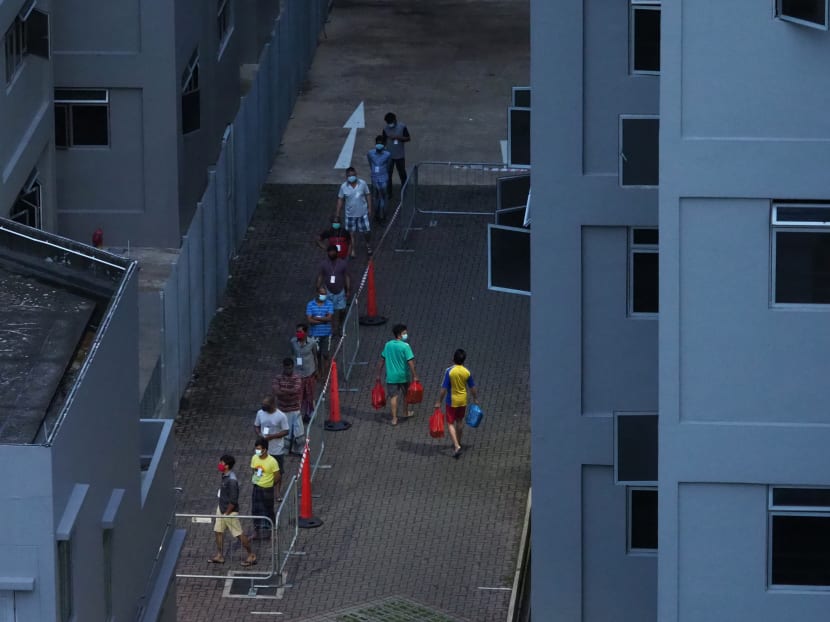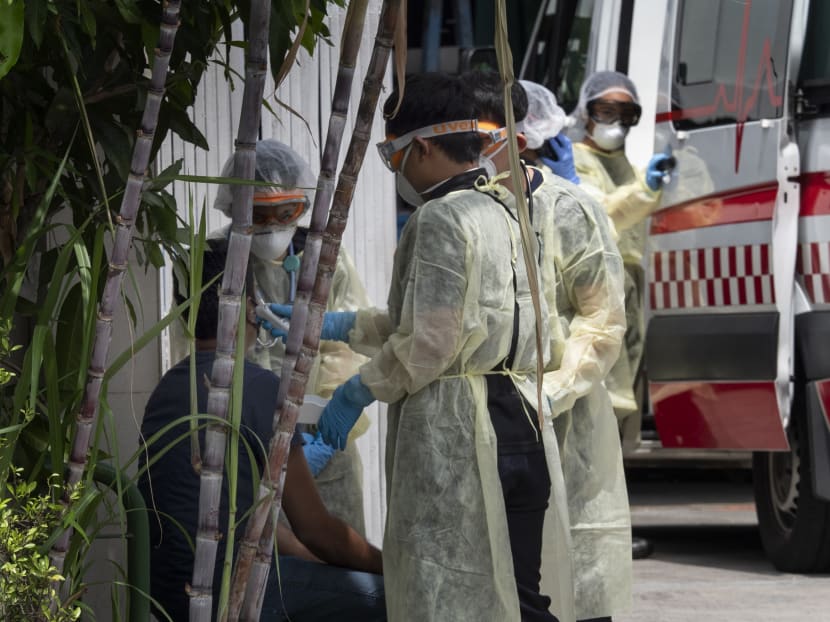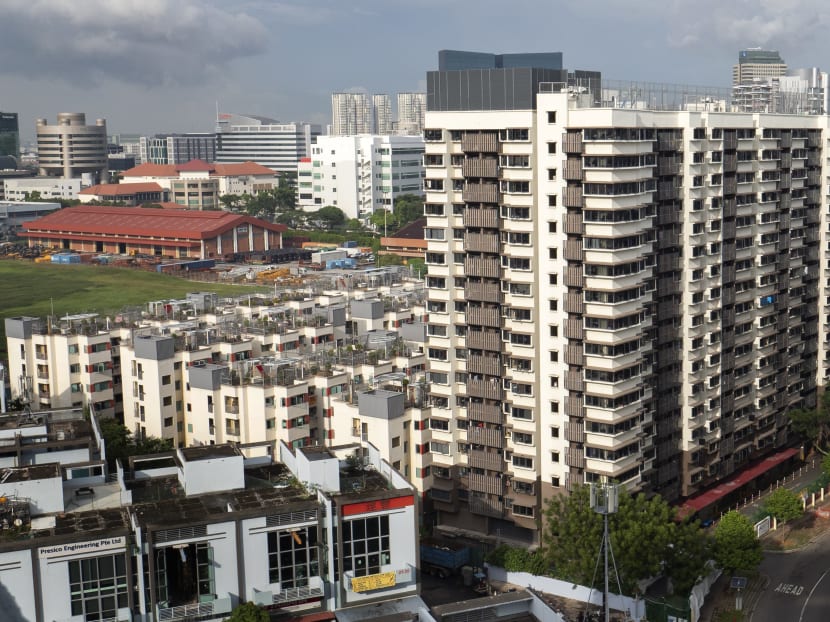The Big Read: Solving S’pore’s foreign workers problem requires serious soul searching, from top to bottom
SINGAPORE — Mr Syedur Rahman Liton, 34, pines for his wife back home in Dhaka, Bangladesh, as he tries to put on a brave front about possibly contracting Covid-19.

For the 400,000 migrant workers living in Singapore, their future could remain shrouded in uncertainty for some time. Their livelihoods here will hang in the balance even after Covid-19 has been eradicated here, say experts.
SINGAPORE — Mr Syedur Rahman Liton, 34, pines for his wife back home in Dhaka, Bangladesh, as he tries to put on a brave front about possibly contracting Covid-19.
For the past month or so, the lifting supervisor has been isolating himself along with 100 other company workers at a factory-converted dormitory in Senoko Loop, part of a precautionary move to socially distance migrant workers living in similar accommodation from the community at large to prevent the further spread of the novel coronavirus.
It is a sacrifice that these foreign workers are making for the rest of Singapore society, experts say. As a result, the country owes migrant workers a debt of gratitude, and possibly, a concrete commitment to change when the pandemic is over.
The number of Covid-19 cases has risen sharply from the first four infections detected at foreign worker dormitory (S11 Dormitory at Seletar North Link) on March 30 which were part of 879 cases in total at that point in time, to more than 21,700 as of Friday (May 8).
Mr Liton has reason to be worried — two of his friends, Asit and Zakir, who live in the larger purpose-built dormitories, have been diagnosed with the disease and hospitalised.
“We all want to go home in good health… My wife miss(es) me more and more,” he said.
When asked about his prospects of remaining in Singapore in the foreseeable future amid the pandemic, Mr Liton said: “I don’t think (I worry) about the future, because I understand the situation.”
But for the 400,000 migrant workers living in Singapore, their future could remain shrouded in uncertainty for some time. Their livelihoods here will hang in the balance even after Covid-19 has been eradicated in the Republic, experts told TODAY.
Amid the crushing impact of the circuit breaker measures and the drastic blow to the construction industry, will Mr Liton’s employer survive the economic drought that has already started? Will he still have a job in post-pandemic Singapore?

While Mr Liton ponders over the future, his host country — Singapore — will also have to reassess its whole relationship with migrant workers like him, especially its “addiction” to cheap migrant labour, and examine whether the lessons learnt from the explosion of Covid-19 cases in the workers’ dormitories could be used to implement meaningful changes.
In the near- to medium-term, at least, what is likely to happen will be a reduction of migrant workers here as economic conditions worsen, said labour economist Walter Theseira.
“At the same time, having fewer migrant workers means more room to make changes,” said the associate professor at the Singapore University of Social Sciences.
With the renewed national attention on migrant workers, the Government has pledged to raise living standards in dormitories when the battle against Covid-19 is over.
Already, there are some suggestions on what these changes can be, from having more living space per worker, more dormitories to house them, and tightening state regulations.
Over the years, Singapore’s history with migrant worker accommodation has seen a general apprehension towards housing migrant workers in the residential community.
In 2008, more than 1,400 Serangoon Gardens residents signed a petition against a dormitory situated in their neighbourhood, which they handed to then National Development Minister Mah Bow Tan.
But beyond the dormitories, there are also wider questions to consider, said the experts.
Should society start questioning its reliance on low-cost foreign workers? Will the economy be able to cope with increased costs of raised standards? Can people accept migrant workers living in their midst?
For some insights into these issues, TODAY reached out to various stakeholders in the industry of migrant labour, such as dormitory operators, construction firms, non-governmental organisations (NGOs), as well as labour academics and policy researchers.
Ultimately, nearly all those interviewed said a significant relook at how Singapore accommodates its migrant workforce, both in the literal and figurative sense, is overdue.
Mr Christopher Gee, senior research fellow at the Institute of Policy Studies (IPS), said: “We can’t go back to the status quo ... We have ridden on our luck for so long and now it has come home to roost.”
THE STATUS QUO
There are some 200,000 migrant workers housed in 43 purpose-built dormitories around Singapore.
These are licensed dormitories housing more than 1,000 workers each and are required to comply with the requirements under the Foreign Employee Dormitory Act (Feda), such as providing facilities that include sick bays and isolation rooms.
Dormitory operators are also required to draw contingency plans in case of a pandemic, such as providing arrangements for quarantine.
Despite this, around 20 of the purpose-built dormitories — nearly half — flout the Feda licensing requirement on average each year, Manpower Minister Josephine Teo revealed in Parliament on Monday (May 4). Operators face fines of up to S$50,000 and up to a year in jail for Feda offences.
Another 95,000 workers are housed in the 1,200 factory-converted dormitories; 20,000 in construction temporary quarters; and 85,000 work permit and S Pass holders in the construction sector housed in Housing and Development Board (HDB) flats, private residential premises and others.
These are not covered under the Feda due to their smaller size, though they have to comply with other regulations such as the building and fire safety codes.
Each purpose-built dormitory house anywhere between 1,500 and 25,000 workers.
By law, the Urban Redevelopment Authority (URA) prescribes a minimum of 4.5 square metres per dorm resident for living space, which includes the sleeping quarters, kitchen, dining and toilet areas.
Operators have largely kept to these minimum standards, as well as other environmental health guidelines by the National Environment Agency that states that there should be one toilet facility for every 15 residents.
Each room can house between 12 and 20 workers, and the beds are often double-decked.
OPERATORS: DORMS NOT BUILT FOR A PANDEMIC
While the purpose-built dormitories have met the needs of the workers during “normal times”, dorm operators said these large facilities were not built nor regulated to cater for a pandemic of such a scale.
A spokesperson from Mini Environment Service (MES), which oversees operations at Jurong Penjuru Dorm 1, Jurong Penjuru Dorm 2, Blue Stars Dorm and The Leo, added that a dormitory “by nature is dense”.
“The older specifications and designs of a dormitory were based on a functional approach and pandemic management was not a consideration in the design and use,” the spokesperson added.
Managing Director of S11 Dormitories Johnathan Cheah said that the dormitories under his charge — S11 Dormitory @ Punggol and Changi Lodge II — are organised to accommodate residents who fall ill with infectious diseases such as chicken pox, measles and mumps.
“(The dormitories) were not designed to accommodate the large number (of infected cases) expected during a pandemic,” he said.
As of Friday, S11 Dormitory @ Punggol is Singapore’s biggest infection cluster, with 2,535 cases.
When asked how the living space each worker has is allotted, the dorm operators said that this is largely up to the specifications of the authorities.
Mr Cheah said that S11 Dormitory @ Punggol was “built to the authorities' specifications for dormitories” when constructed in 2015.
Agreeing, the MES spokesperson said: “We don’t get to decide on the living space. This is set by the authorities and the dormitories are built to specifications.”
Help from the authorities
As infections in dorm clusters began to rise early last month, an inter-agency task force was set up on April 7 to provide support to foreign workers and dormitory employers.
With help from the authorities, operators have been able to lower occupancy rates within the dormitories.
Mr Kong Chee Min, the chief executive officer of Centurion Corporation, who is in charge of ASPRI-Westlite Papan, Westlite Juniper, Westlite Mandai, Westlite Toh Guan and Westlite Woodlands, said that the leased tenancy of these dorms averaged 95 per cent or higher, while the actual residency was around 85 per cent.

Thanks to the “concerted decamping efforts supported by multiple parties nationally” in the wake of the pandemic, occupancy has been brought down to about 65 to 70 per cent on average.
“On average, there are now about five or six persons living in an eight-bed apartment, and eight to nine persons in a 12-bed apartment,” said Mr Kong.
Likewise, the operator at S11 Dormitory @ Punggol has been “working very closely” with the authorities to curb the spread of the virus.
For example, the residents are required to stay in their assigned rooms and cannot come into contact with the other residents in different levels and blocks.
This measure is part of a three-pronged strategy announced by Manpower Minister Teo on April 14.
Future hopes for dorms
The operators hope that the next couple of years will bring improvements to the conditions and living standards within the dormitories.
“A review of standards for dormitory operations can only be good for the foreign worker community as it will help to raise quality levels across the industry,” said Mr Kong.
Agreeing, the MES spokesperson said that the ability to “tear down” the dormitories with older specifications and update them will “benefit all stakeholders”.
The issues which the operators would like to address include the long-standing conundrum of safe distancing.
“If we are to prepare for future pandemic situations, the density of the dorm population needs to be addressed and employers need to set aside higher budgets for rentals, for instance,” said Mr Cheah of S11 Dormitories.
Beyond deciding where to house the workers, employers also play a “major role” in regulating the way employees use the premises, operators say.
Mr Kong said: “We do see employers who rent 12-bed apartment units, then choose to house only 10 or less workers in the apartment.”
EMPLOYERS: ‘OUR HANDS ARE TIED’
Limited influence on their workers’ living conditions
While migrant workers are covered by Singapore’s main labour law, the Employment Act, employers of migrant workers also generally assume a greater responsibility for their welfare, including food accommodation and healthcare, than if they had hired a local resident to do the same job.
But while employers in the construction sector agree that changes to how migrant workers are housed are needed, several told TODAY that the influence they have on their workers’ living conditions is limited.
It is largely not up to the employers to dictate the density or the living conditions within the dormitories, but for the operators to decide and the authorities to regulate, they claimed.
Mr Johnny Lim, executive director of Teambuild Engineering & Construction, noted that purpose-built dormitories are often densely populated due to the shortage of land and “concerns that these dormitories are in too close proximity to residential areas”.
Mr Chew Char Choon, senior project manager of a real estate construction firm, said: “As a contractor or dorm operator, we just take instructions from (the authorities) ... It is up to the Government, how they would like to control.”
While maximum room capacity and space for each worker may be set by the operators with prevailing regulations in mind, some employers may choose to house their workers in more spacious environs — but at a cost.
Mr Nelson Tee, managing director of CHH Construction System, has been housing his 39 workers in three dormitory rooms that can hold a total of 48 workers.
He pays S$369 per worker monthly for their accommodation when he could have been paying S$300 had he housed them to full capacity, and has been doing so before the pandemic.
“I book them for three rooms so I can spread them out,” he said.
More space will come at a cost
Should new guidelines cause housing to be more costly, not all contractors may be able to stomach this, the employers said. This is especially if they have long-term projects underway, some of which can last four to five years.
Mr Chew said that should dormitories charge higher rates per worker, it would “not be fair to ongoing contracts, which are tendered based on old pricing”.
“When the new guidelines come in… it will affect (employers’) cashflow.”
At the end of the day, some employers think it boils down to who would be willing to shoulder and split the extra costs.
Mr Akbar Kader, managing director of Nan Guan Construction, said that he would like to see a “symbiotic arrangement” between the employer, dormitory operators, and the authorities, such that the extra costs are fairly distributed among them.
He added that a maximum rental charge would also make future operators more mindful during the tendering process — when they bid for the price of land on which to build their dormitories.
Exorbitant bids will be fewer if operators “know that they would have to provide specified facilities and meet operational requirements, and charge no more than what has been stipulated as the (maximum) price for rental of a bed space”, he said.
If all the above is carried out, “the increment in cost (to the consumers) over the time they own the property will be very minute”, said Mr Akbar.
Some employers think that consumers should also see beyond the economic cost of the product and be mindful of the workers’ efforts that go behind it.
Mr Kenneth Loo, executive director of Straits Construction Singapore, said that most Singaporeans are not aware of the workers’ hard work, and the tough living conditions they have to put up with.
“How much people are willing to pay depends on the economy (rather than the workers’ living conditions),” he said. “For example, when you buy a piece of clothing, do you think of where it comes from? No, right?”

A push towards automation
Over the years, some employers have also turned to technology to help reduce their reliance on foreign labour.
For example, Mr Lim from Teambuild Engineering & Construction said the firm focuses on prefabricated prefinished volumetric construction (PPVC), whereby entire rooms are first prefinished and fitted out in factories with the use of automation and machinery, before being transported on-site for assembly.
These new construction methods “effectively transferred major portions of the work previously carried out on the construction sites into the factories”, he said.
However, there is a limit to automation. Unless technological advancement allows machines to “function like tradesmen” and be available, accessible and affordable, “construction will remain a labour-intensive industry”, Mr Lim said.
While both dorm operators and employers say their hands are tied when it comes to housing, commentaries over the past several weeks have jointly blamed the inadequacies by both parties for the outbreak.
Experts tell TODAY that the time will come for a review to identify where the lapses are.
Assoc Prof Theseira said: “Employers and operators are quite a diverse group. Some appear to have neglected their responsibilities, others have simply been overwhelmed, and others still have discharged their responsibilities well. We really need some time to identify who did well and who didn't, and hold those who failed to account.”
GOVT: ROLE AS REGULATOR
Raising the Feda bar
As the authorities hunker down to mitigate the viral spread, the Government is also looking into new housing arrangements for migrant workers who have recovered from Covid-19 through a pipeline of short, medium and long-term plans, said National Development Minister Lawrence Wong.
Mr Wong co-chairs the multi-ministry task force leading Singapore’s response to the Covid-19 outbreak.
While details of these plans are not yet known, several suggestions have been raised, most notably, to increase the minimum standard for living space specified in Feda.
After all, it is too much to expect private operators and employers to do so on their own, said Mr Alex Au, vice-president of migrant worker rights group Transient Workers Count Too (TWC2).
“Employers and dorm operators have to watch their bottom lines. They are not welfare services. If the legal standards are low — which we feel they are currently — they would be foolish as profit-making enterprises to over-provide and drive up their own costs.
“That's what the Government is for — to ensure socially-conscious minimum standards, but to do so in an across-the-board way so that a level-playing field for all businesses is maintained,” he said.
Mr Au called for a doubling of the living space per occupant to 9 square metres — equivalent to 10 workers living in a four-room HDB flat.
Assoc Prof Theseira, a Nominated Member of Parliament (NMP), said a proper study is needed to determine what construes a reasonable standard for living space.
“If we come up with one set of standards for living for Singaporeans in a similar situation, for example, a long-term hostel, dormitory, or army camp residents, it would be quite unjust to apply a lower standard to migrant workers just because they are migrant workers,” he said.
The Migrant Workers’ Centre (MWC) also urged for changes to the Feda to include all migrant worker housing facilities regardless of their size or type, stripping away the 1,000-bed threshold which allows the law to kick in.
Said MWC chairman and former Member of Parliament Yeo Guat Kwang: “This is something MWC has been calling for since the enactment of Feda, on the evidence that the majority of the sub-par housing facilities we see and investigate in the course of work continue to come from factory-converted, or smaller dormitory facilities.”
Other suggestions from MWC include a minimum dormitory staff to residents ratio, so as to ensure that operators have sufficient manpower to carry out crucial work such as cleaning, operations support and security.
More open green space should also be part of the dormitory requirements, which would allow for recreation and communal activities.
Labour economist Kelvin Seah from the National University of Singapore’s (NUS) Faculty of Arts and Social Sciences said that these plans should include strategies to raise the hygiene standard in dormitories.
“For instance, the plan may want to prescribe the regularity in which toilets, kitchens, and rooms would be cleaned, and the sanctions which dorm operators or employers may face if they fail to comply,” said the senior lecturer.
But these suggestions would likely lead to substantially higher costs of housing migrant workers, added Dr Seah.
DBS bank analyst Ling Lee Keng, who frequently reports on the commercial performance of the purpose-built workers accommodation sector, said that a more stringent law could result in a cutback in the supply of beds.
“That could benefit the dormitory operators that are able to meet the higher operating requirements — bigger rooms and better facilities would naturally lead to higher cost per bed,” said the analyst, who had previously predicted that raised standards could lead to a consolidation in the industry.
A more direct role for the Govt
Aside from regulations, could the Government also play a more active role in dormitory management?
Speaking at an IPS webinar on Wednesday (May 6), Associate Professor Jeremy Lim, who is the co-director of Global Health at the Saw Swee Hock School of Public Health, NUS, noted the existence of two separate “mental models” that the authorities had for migrant workers and for the larger Singapore community.
The policy response was guided by these mental models, that although migrant workers are part of the community, there are separate paradigms for the two groups, he said.
Employers of migrant workers assume the responsibility for the workers’ welfare, including healthcare, accommodation and food. Assoc Prof Lim said this is evident from the onset of the pandemic when the MOM asked dormitory operators to step up hygiene measures and issued advisories to employers.
“As it became clear that employers were overwhelmed in terms of safe distancing and (providing) face masks, everything fell apart and the Government had to step in. To their credit, the Government mentally pivoted away from this mental model… quickly,” he said, noting the speedy establishment of community care and recovery facilities to house affected workers.
Several observers had mixed feelings about the Government playing a more direct role in day-to-day dormitory management. Such services are best provided by the private market, said Dr Seah.
But the Government could also take a leaf from the book for public transport operators which do not own the buses and trains, or from how the management of state-owned buildings are tendered out to commercial service providers.
Assoc Prof Theseira said: “Having dormitories owned by the Government, and then managed on a competitive basis by private companies accountable both to workers and the Government, may be an interesting model to consider.”
Tweaking Singapore’s economic model
A more fundamental question would be whether Singapore should continue to rely heavily on low-cost migrant workers, said experts.
In Singapore, past crises have historically led to a rethinking of the Republic’s social compact — the combined series of unprecedented crises such as the 9/11 terrorist attacks in the United States in 2001, the Sars outbreak in 2003 and the global financial crisis of 2008 required national responses that “threw our planning out of gear” and necessitated the 2013 Population White Paper, said then Deputy Prime Minister Teo Chee Hean.
With Singapore now facing what has been touted as “a crisis of a generation”, some, like Assoc Prof Theseira and fellow NMP Anthea Ong, have called for a committee of inquiry into the foreign worker dormitory outbreak to work out the structural changes that Singapore sorely needs.
In his reply to the NMPs’ call, Minister Wong told Parliament on Monday that the Government will review its overall response to the pandemic comprehensively in order to learn and improve.
Deputy Prime Minister Heng Swee Keat has also set up an Emerging Stronger Task Force, which is tasked with making recommendations on how to reimagine Singapore’s economic strategies.
One silver lining, from a policymaking perspective, is that the current worries about Singapore’s overreliance on migrant workers are aligned with the Government’s goal of raising the productivity of the resident workforce.
This dates back to 2012, when then Finance Minister Tharman Shanmugaratnam said the easy availability of foreign labour will reduce the incentives for companies to raise productivity.
Since then, Singapore has taken steps to progressively reduce this reliance, such as tightening the foreign worker dependency ratio ceilings, said Dr Seah.
“There is scope to reduce this reliance even further. By encouraging companies to rely less on foreign labour in their production processes, we can in fact nudge them to adopt smarter and less costly methods of production,” he added.
Associate Professor Kenneth Paul Tan, from the Lee Kuan Yew School of Public Policy, said he hopes the review on dormitories, when it comes, will take in diverse voices from civil society in policy discussions.
“And I hope, most of all, that we have deeper discussions with a view to minimising our dependency on low-waged migrant workers, investing in productivity-enhancing technology, redesigning essential jobs to overcome unnecessary stigma, and designing more generous social safety nets for the many who will have difficulty integrating into a new and more resilient economic society.”
PEOPLE: SOCIETY’S APPETITE FOR CHANGE
IPS’ Mr Gee said that this traditional mindset of relying on lower-skilled and low-wage labour has created a “category of residents who have limited rights as a non-permanent resident foreigner and are treated differently”.
If Singapore decides that in a post-pandemic world, it needs to elevate their living standards to a decent level that Singaporeans can accept for themselves, then another question will be what level would Singaporeans be comfortable with, said Mr Gee.
“The same level as the lowest-paid Singaporean household? Or lesser? We have to negotiate and discuss this,” he said.
And then, there is also the matter of cost that society needs to bear.
Last month, amid the outbreak in the dormitories, Mrs Teo said that each time MOM attempts to raise the standard of living in these premises, it would face objections from employers due to the added costs that come with the move.
“Nevertheless, I hope the Covid-19 episode demonstrates to the employers and wider public that raising standards at worker dormitories is not only the right thing to do but also in our own interests. We should be willing to accept the higher costs that come with higher standards,” she said.
In this fundamental re-think of the role migrant workers play in Singapore’s prosperity, TWC2’s Mr Au urged the authorities to also look beyond living standards in dormitories, such as long-standing issues on the recruitment fees that migrant workers bear and the non-payment of salaries.
Assoc Prof Theseira said: “Fundamentally, the current structure is low-cost, and as a result, generally Singaporeans benefit in the narrow sense that we pay lower prices for anything produced by foreign workers.”
“Either our costs would go up, meaning more taxation, or standards would fall, meaning more potholes, uncleared fallen trees, et cetera, without so many low-cost workers.
“That means that we have collectively contributed to current conditions for foreign workers, because we have found these low costs and high standards of service too compelling to raise too many questions about their treatment and the market structure,” he added.
S’poreans’ attitudes towards migrant workers
So, are Singaporeans willing to pay for the higher costs that will inevitably arise from offering migrant workers a better deal? The jury is still out, based on past experience, according to the experts interviewed.
The empirical evidence suggests that the mindset of Singaporeans towards migrant workers has not changed, despite an outpouring of sympathy whenever a major incident occurred.
At the IPS webinar, MWC executive director Bernard Menon lamented that despite past events such as the SMRT bus driver strike in 2012 and the Little India riot the following year, the momentum arising from the online discourses on worker welfare would eventually peter out.
“We have a lot of people coming up and saying ‘you should improve this, you should improve that’,” said Mr Menon.
“But unfortunately, though you can obviously tell that there’s been a gradual increase over time of interest and concern… this has lagged behind the expectations I’ve had during these crises.”
Most recently, in December last year, the International Labour Organisation and the United Nations Entity for Gender Equality and the Empowerment of Women jointly published a detailed study into society attitudes towards migrant labour in Japan, Singapore, Malaysia and Thailand. The study included both work permit holders working in the construction industry and foreign domestic workers as part of their report.
It found that overall support for migrant workers had decreased in the past nine years, when a similar study was conducted in 2010.
“Knowledge regarding migrant workers across the four countries remains low, and discriminatory attitudes prevail with significant numbers of members of the public in migrant destination countries stating that migrant workers should not enjoy equal working conditions with nationals,” the report stated.
The study found that 36 per cent of the 1,005 Singapore respondents believed migrant workers should not receive the same work conditions as local workers, or be entitled to join a union.
Around 40 per cent said migrant workers who end up exploited only have themselves to blame, a majority — 60 per cent — disagree that migrant workers should receive the same pay and benefits as nationals, and 53 per cent said migrant workers threaten the country’s culture and heritage.
Nevertheless, a majority of the Singaporean respondents (58 per cent) recognised that migrant workers had a net positive effect on Singapore’s national economy.
A round of soul-searching
With the pandemic forcing Singapore — as a collective — to pay the price for years of apparent neglect, commentators said that after Covid-19 is eliminated, Singapore needs to openly embark on some serious soul-searching.
For a start, the society’s mindset and attitude towards migrant workers need to “undergo a sea change”, said Associate Professor Eugene Tan from the Singapore Management University.
“SG United must include migrant workers from the get-go ...We cannot, as a society, seek to harness the benefits of their being here and yet not prepare to bear the costs of their being in our midst. We cannot continue to have the gains privatised but the costs socialised in our migrant worker policy,” the law don said.
As Singapore figures out its next steps for migrant workers, the workers are also trying to figure out theirs as they mill around in their rooms within the various dormitories dotting Singapore keeping a distance from everyone else.

Having spent more than a decade working in Singapore, Mr Liton is keenly aware of the value of social inclusion. Like his friends Asit and Zakir, Mr Liton is a poet, who often pens his thoughts about crises and conflicts around the world, and attends poetry events with Singaporeans such as those organised by Sing Lit Station and local Bengali publication Bangla Kanthar.
Isolated in his company dormitory now, he spends the idle days reading the news online, watching movies, and making video calls to his wife and family back home, he told TODAY.
On April 17, he wrote in Bengali: “The whole world drowned in darkness today / Every person surrounded by death, disorder and the virus / Humanity is counting down the hours of waiting / For when the end comes — A new dawn.”
CORRECTION: In an earlier version of this article, we stated that migrant workers are not protected by the Employment Act. This is incorrect. The Act covers work permit holders, with some exceptions. We are sorry for the error.













